The simple guide on how to make healthy homemade Greek yogurt (with just two simple ingredients)! Learn how to make delicious and creamy Greek yogurt with this easy recipe. With just a few simple ingredients and some basic equipment, you can enjoy homemade Greek yogurt that is healthier and more flavorful than store-bought versions.
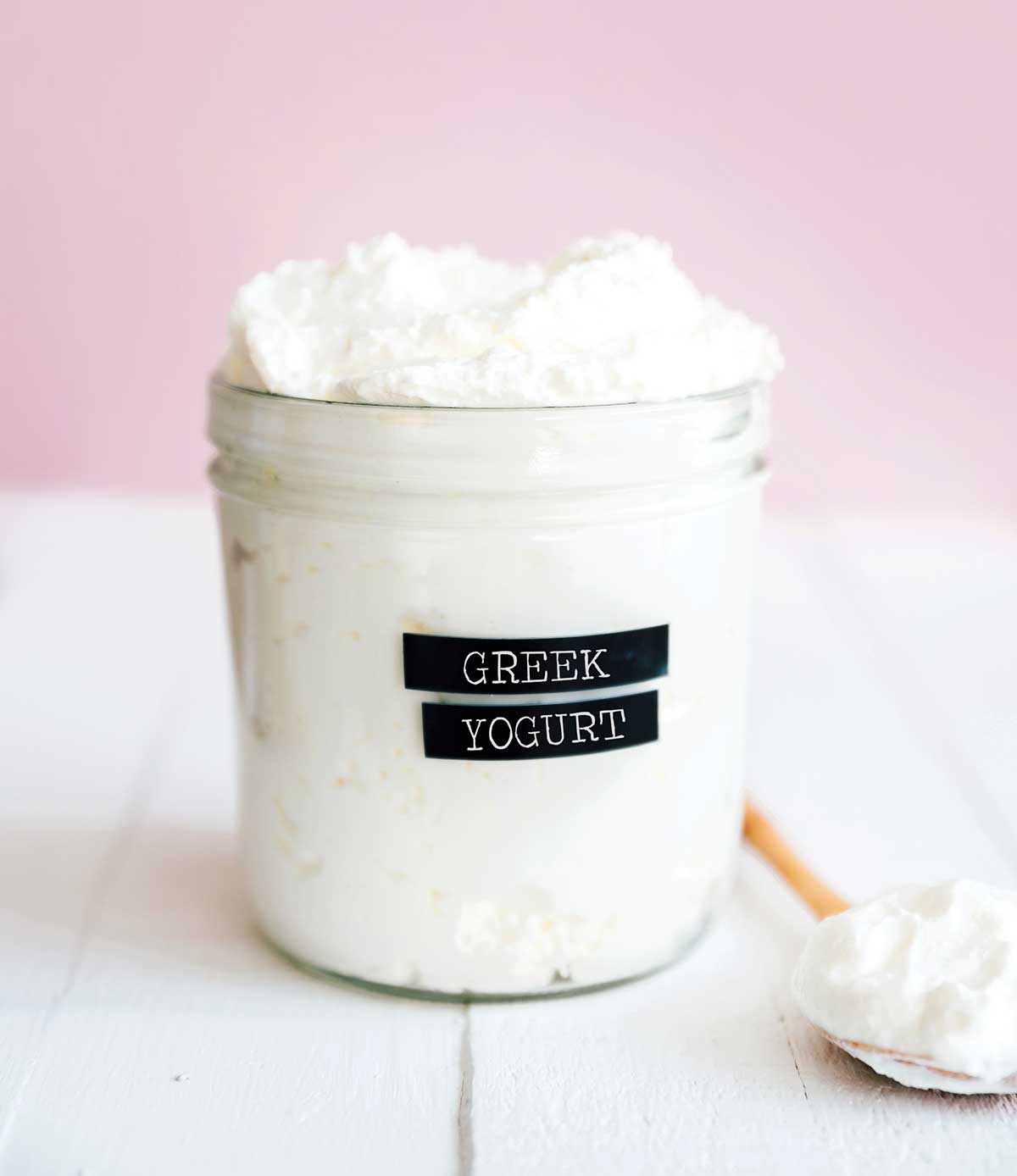
How to make Greek yogurt video
What is Yogurt?
Well milk is made up of casein and whey. Casein is what curdles and is used to make cheese and yogurt, while whey is the watery substance left when the milk curdles.
So what is Greek yogurt? Greek yogurt is essentially the same as regular yogurt with the addition of one critical step – straining! At the very end, the yogurt is strained to remove the excess watery whey, creating a thicker, more protein-dense product. So while we call this variation of yogurt “Greek yogurt” in the U.S., you may see it called “strained yogurt” in other areas of the world.
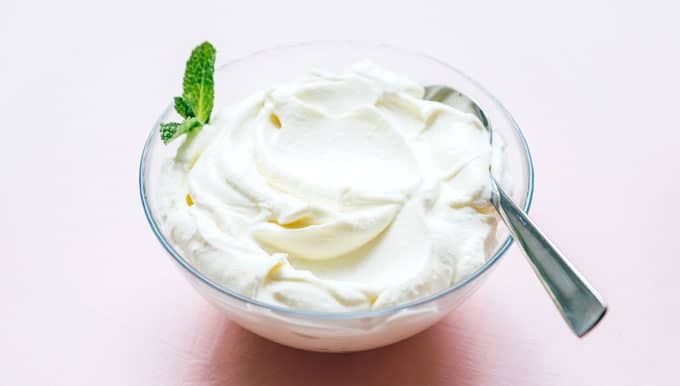
Homemade Yogurt Ingredients
Yogurt is a fermentation (just like kefir, kombucha, and kimchi), meaning it’s created by adding some bacteria (yogurt) to a sugar-containing substance (milk) and letting the bacteria eat up the sugar. So to make yogurt at home, you’ll just need 2 ingredients:
- Yogurt: Make sure to use a good quality yogurt that has “live” or “active” cultures.
- Milk: Whole fat milk produces the best texture for homemade yogurt.
The result of fermentation is always acid, gas, or alcohol. Fermentation of milk gives us acid, making for the distinctively tart flavor of yogurt!
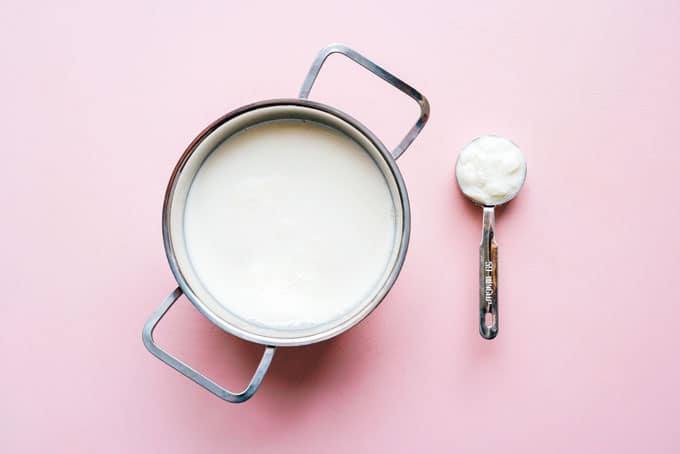
How to make Greek Yogurt
Step 1: Heat Milk
Heat milk to 185 degrees F (85 degrees C). This is important for creating a thick, nicely textured yogurt.
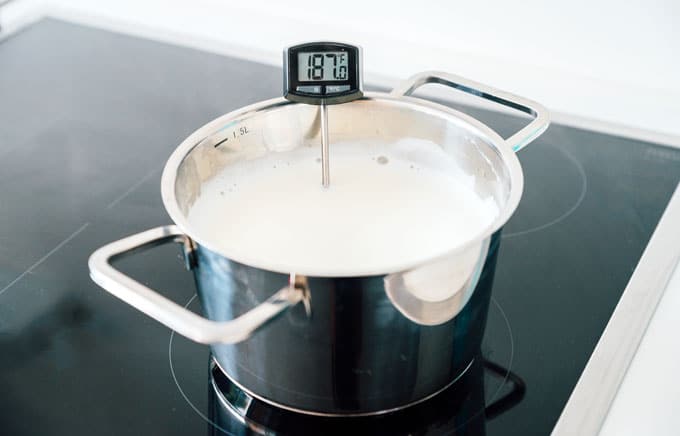
Step 2: Cool Milk
Cool milk back down to lukewarm (about 110 degrees F, 43 degrees C), then add 1/2 cup of the warm milk into the yogurt. (Ensuring the milk is cooled down will prevent you from killing the live cultures in the yogurt.) Whisk the yogurt and milk together, then add the rest of the milk and mix well.
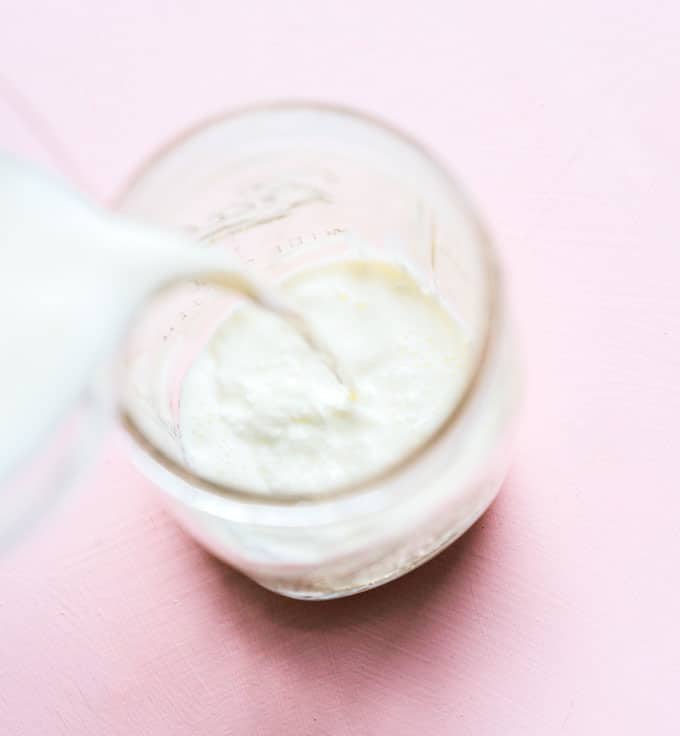
Step 3: Let Sit
Place your mixture somewhere warm and let sit for 4 to 8 hours, or until yogurt is thick and tangy. My favorite method for making yogurt is to wrap the jar in a warm, moist towel, then setting it in the oven with the oven light on. The light will provide enough heat to ferment the yogurt!
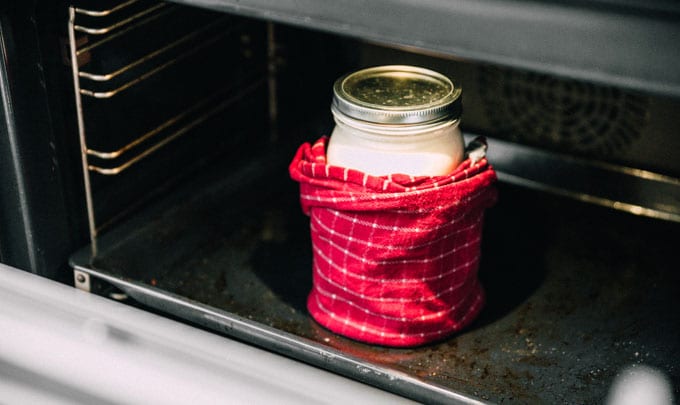
After sitting in a warm environment for a few hours, your yogurt is ready to eat! If you want to turn this plain yogurt into Greek yogurt, we’ll take it one step further and strain it.
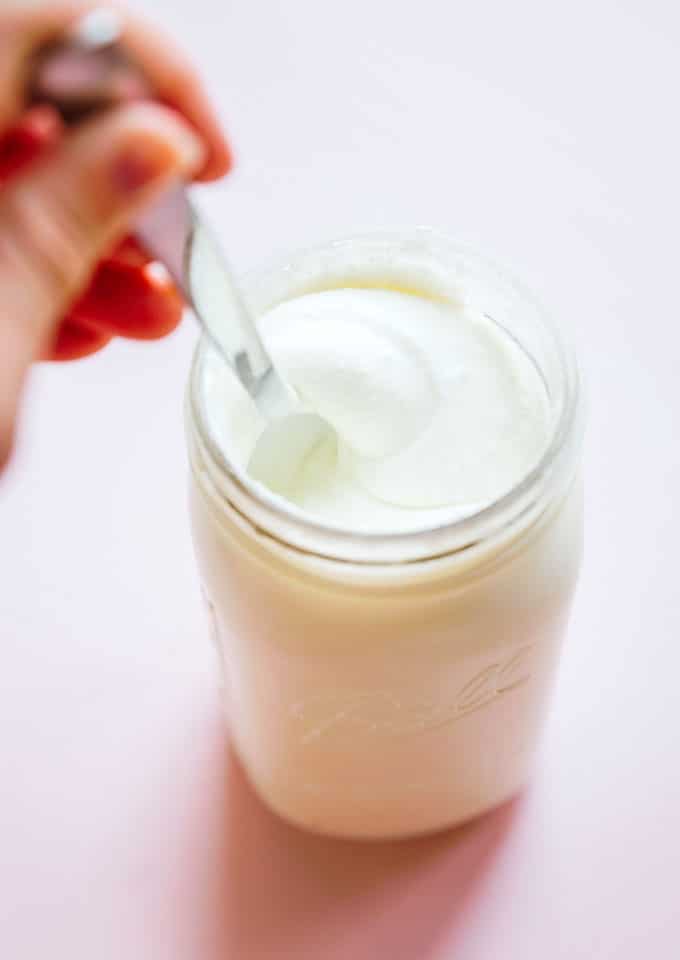
Step 4: Strain
Set a mesh sieve lined with cheesecloth (or strong paper towels) over a large bowl. Pour in yogurt and place in the fridge. Check every few hours until yogurt reaches your desired thickness.
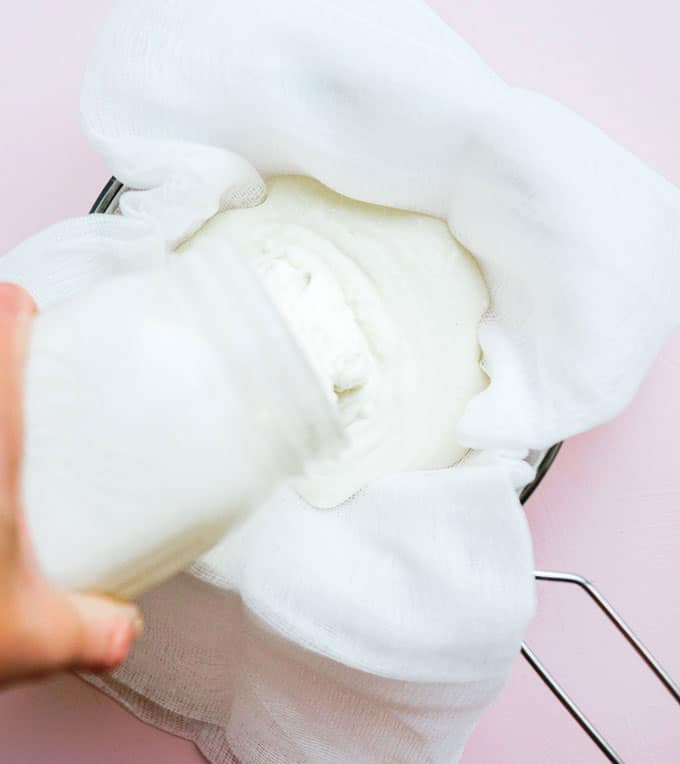
The liquid that is drained out of the yogurt is whey! This is a great protein and works well in smoothies and soups.
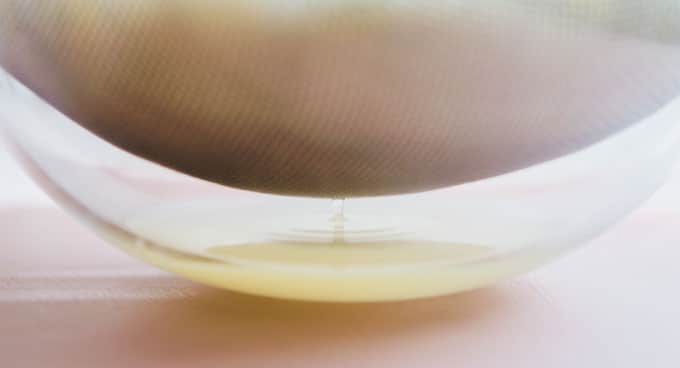
Transfer your freshly made Greek yogurt to an airtight container when it has reached your desired thickness level!

Greek Yogurt FAQs
Is Greek yogurt healthy? Yes! Greek yogurt is more protein-packed than regular yogurt because we skim out excess moisture.
Can you make Greek yogurt with skim milk? It’s best to use milk with some fat in it to give your homemade yogurt a nice texture. I’d recommend doing a blend of skim and 2% if you are going to try for a low fat homemade yogurt.
How do you make non-dairy Greek yogurt? Making non-dairy yogurt at home is another ball game and requires a different way to introduce live bacteria (in the form of probiotic supplements!) This recipe from Minimalist Baker is great for the non-dairy yogurt seekers.
Is it cheaper to make your own Greek yogurt? Yes! According to Project Meal Plan, homemade Greek yogurt is almost 15 cents cheaper per ounce than store bought.
How did yogurt originate? Yogurt came to be right around the time when humans started drinking animal milk, which was just about the time when we learned to domesticate animals, so 8000 years ago. Back then, milk was stored in (brace yourself) animal stomachs. The natural enzymes and bacteria in the stomach would cause the milk to curdle and ferment, producing yogurt and cheese! Yogurt has made it’s way into most nooks and crannies of the world, but it didn’t become popular in the U.S. until the 1950s and 60s, when health foods began to gain some traction.
Best Sauce…Ever?
Use your freshly made Greek yogurt to make this easy Spinach Artichoke Dip, Healthy French Onion Dip, or Fruit & Yogurt Popsicles!
But my FAVORITE way to use Greek yogurt? In this quick and easy tzatziki sauce! Tzatziki is refreshing and creamy, and the perfect way to use your homemade Greek yogurt.
Be sure to try our other fermentation projects, like kimchi, kefir, tepache, sauerkraut, and kombucha!
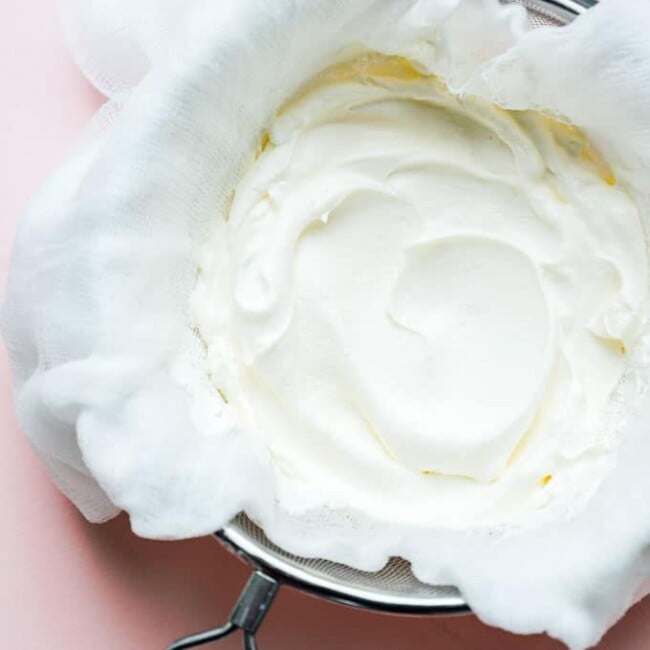
Ingredients
- 4 cups whole milk 960 mL
- ¼ cup plain store bought yogurt ensure the container says “live” or “active” cultures, 60 g
Instructions
- Heat Milk: Place milk in a medium pot and heat to 185-200°F (85-93°C), stirring frequently to preventing a skin from forming.
- Cool Bath: Transfer the pot with milk to an ice bath (I filled my sink with ice and water), to cool milk to 100-110°F (37-43°C).
- Temper: Pour ½ cup of the warm milk into a separate clean jar or bowl. Mix in plain yogurt, stirring until yogurt is well blended. Add remaining milk and mix well.
- Let Sit: Cover jar or bowl with a lid, wrap in a moist, warm towel to keep in heat, and place in oven. Turn on oven light to keep warm, and let the bacteria do its yogurt making magic for 4 to 8 hours (or overnight).*
- Strain: You can eat the yogurt like this, or strain it to make Greek yogurt. To strain, line a mesh sieve with cheesecloth (or paper towels, coffee filters etc), and pour yogurt in. Place over a large bowl and let strain in the fridge for a few hours (or overnight), until it’s reach a consistency you like.

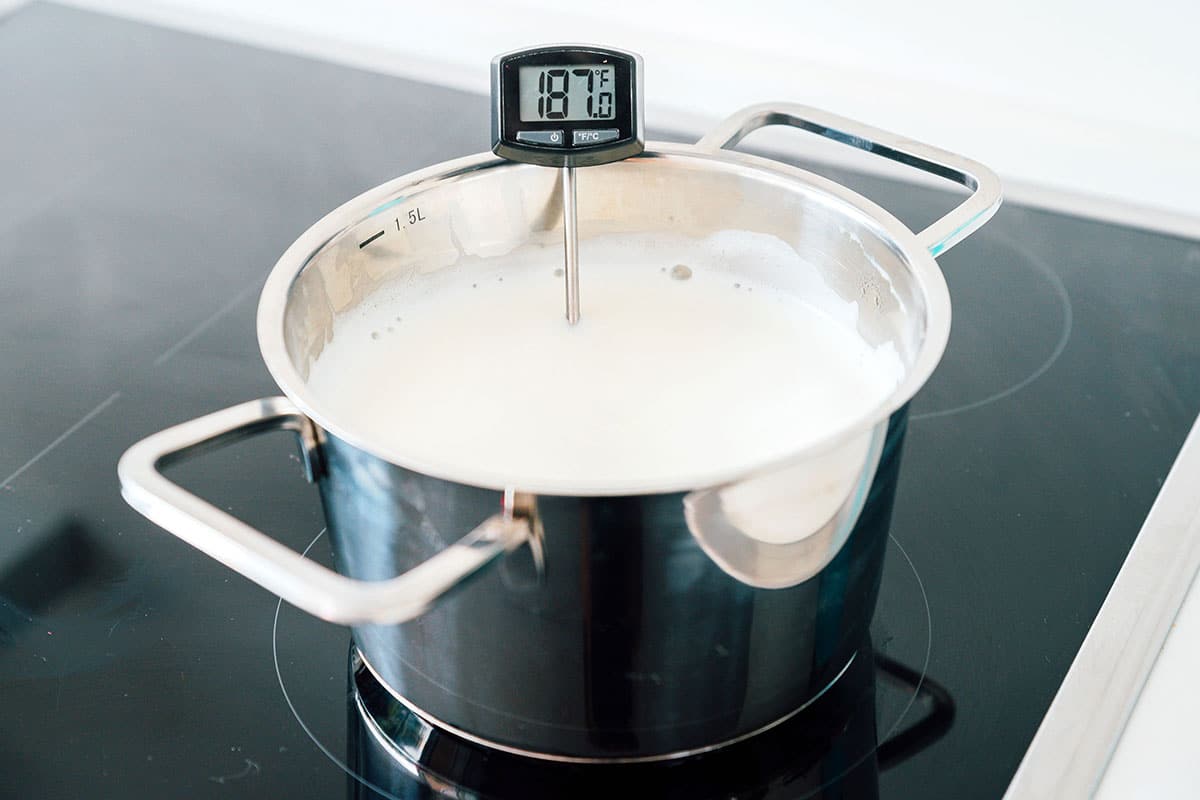
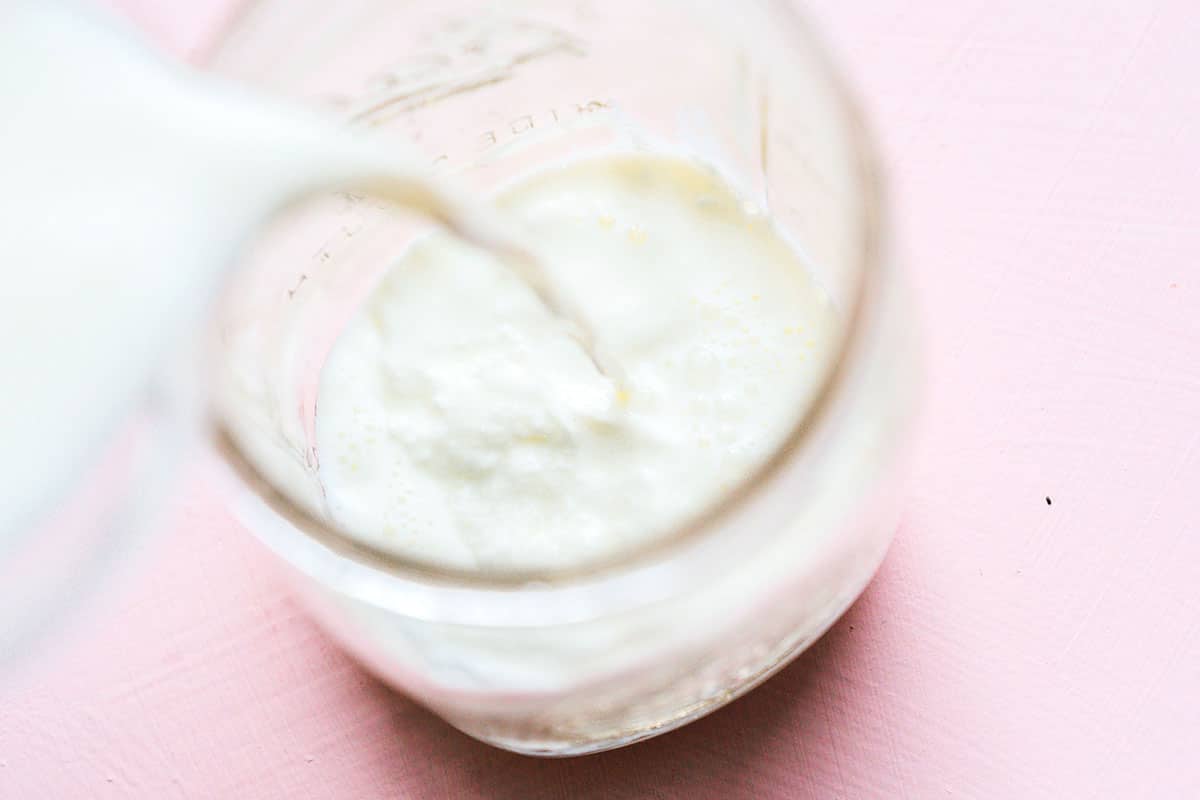
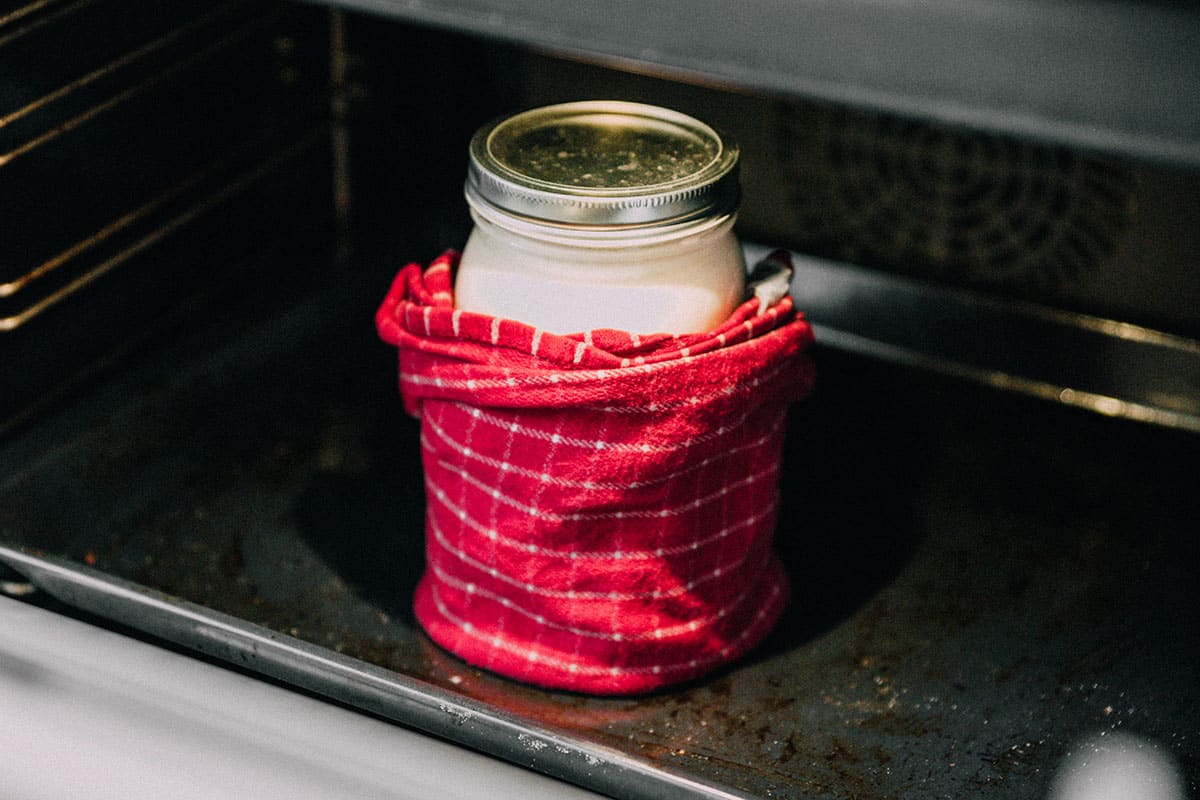
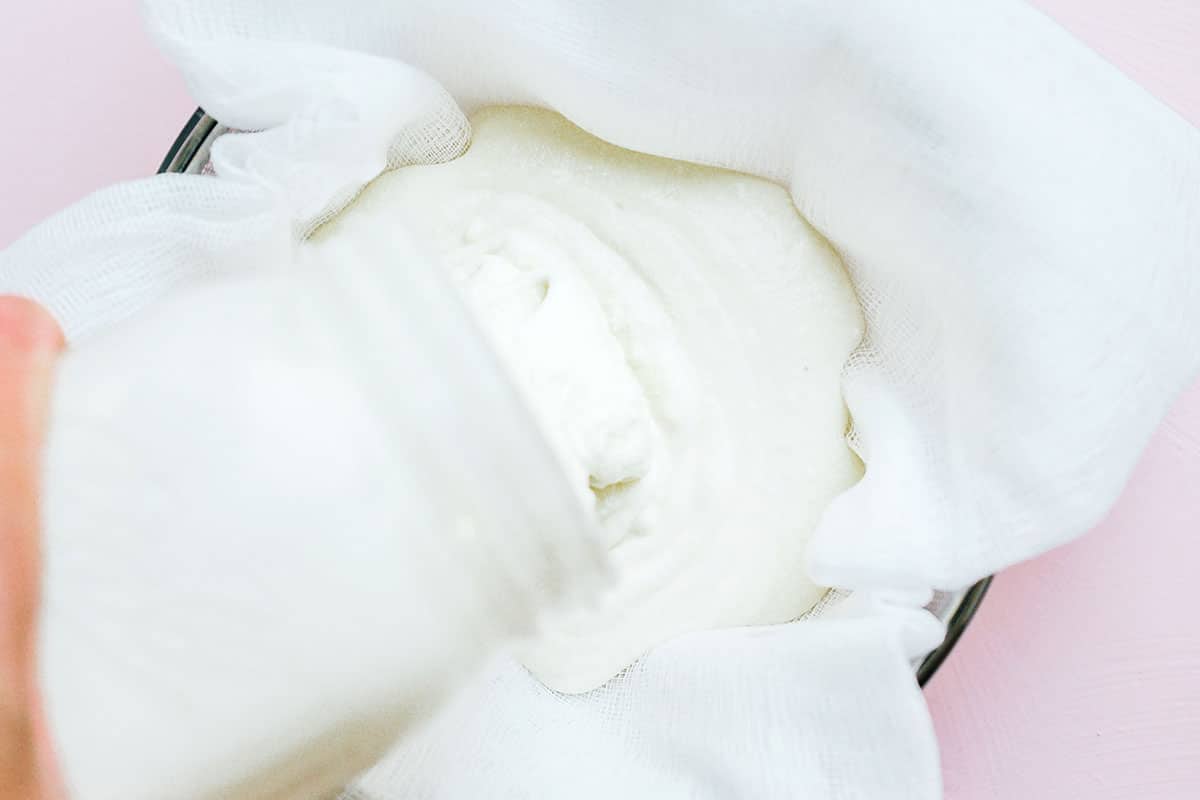
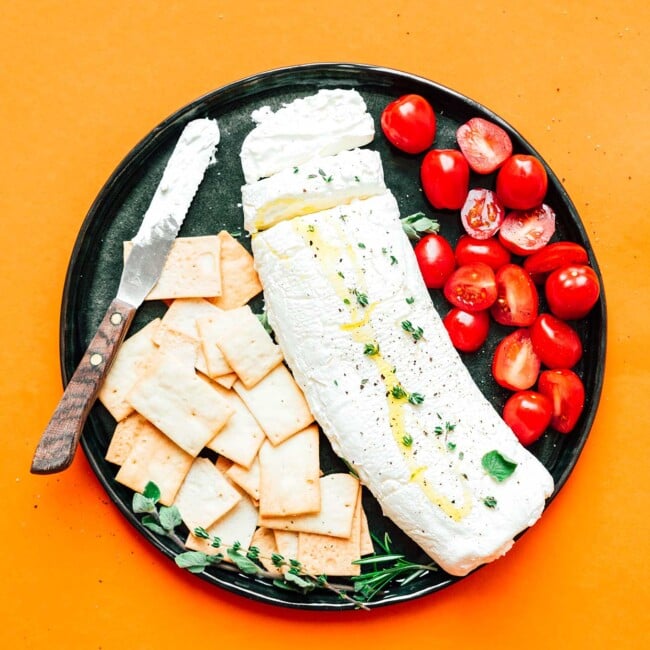
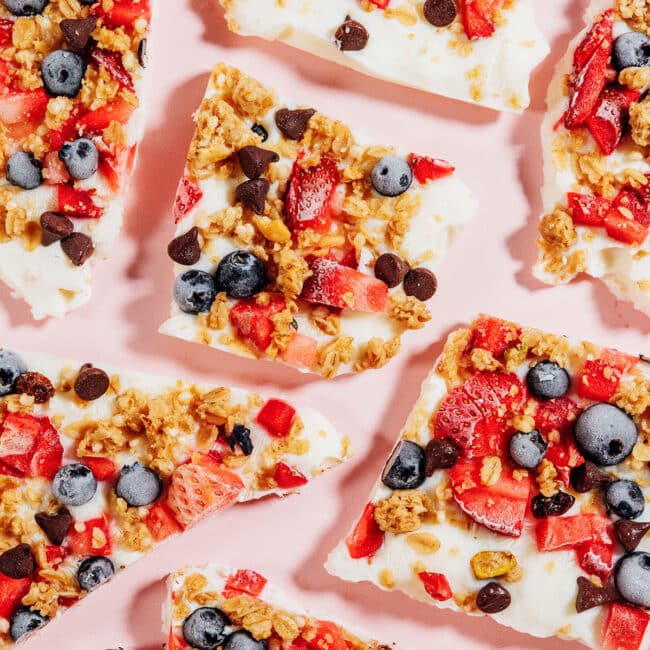


Lori says
Can’t wait to try it! How can I make vanilla and other fruit yogurts?
Sarah Bond says
You would just add those after your yogurt is finished! Start with a small amount of vanilla extract and work up. For fruits, you can puree fresh fruit and stir them in 😀
Cheryl L. March says
I’m so confused on why there’s a recipe to make yogurt out of yogurt.. I mean it’s already yogurt but I can understand if it were merely how to turn yogurt into Greek. I want to know how to add berries for flavor. Also if you’re turning the oven on there’s really no savings but great idea to make Greek yogurt.
Sarah Bond says
You need a tiny bit of yogurt as the starter to make a lot of yogurt (it has all the bacteria in it to get things going!)
Jim_d says
Running my 40W oven light for the max 8 hours of this recipe costs me $0.0472 USD. My cost to make it is roughly $1.25 per 32 oz ($1.00 milk + $0.14 stove electricity + $0.05 oven light). You might be able to find it at that price, I can not. I would be spending at least $6.00 per 32 oz of Greek yogurt from the store unless it’s on sale. Making more things from the same milk helps in it’s own ways as well though. Making yogurt, ricotta, skyr or something else can also be a great way to use up extra milk before it goes bad. After making yogurt, I put away a quarter to half a cup of it to inoculate the next batch.
Chrissy H says
Most people I know, make their own yogurt for the health benefits. Store bought yogurt does not have ALL the good bacteria your gut needs to function properly. Most of your health is a direct cause of your gut health. Even Most skin issues like eccsama etc are caused from bad gut health. Store bought yougurt (no matter what the label states) does not have enough good bacteria to be bennificial for your health. The grocery store will decieve you at every turn.
Chris Thomson says
Hi, in the photo it looks like you are using a normal size Mason jar which I think holds two cups? Do I need to do an eighth cup yogurt per two cups of milk for two jars? Or do you have a four cup jar suggestion? Thanks in advance.
Chris Thomson says
Disregard this question–I have a Mason jar that does hold four cups.
Sarah Bond says
I believe this is the 4 cup (quart-sized) mason jar pictured! The size honestly doesn’t matter much though, just keep ratios the same 😀
Carole says
Just made yoghurt for the first time ever – it’s delicious! My oven has a bread proving setting (couldn’t find how to just have light on!) which meant I didn’t have to wrap in towel – easy peasy 😊
Noah says
How can you make this Non fat Greek yogurt? Thats what we usually buy…
Sarah Bond says
That’s a bit tougher actually, and you may have to supplement with milk powder!
Lauren DeMeo says
I followed the instructions and in the end the consistency is still super thin just like the milk? What went wrong?
Sarah Bond says
It sounds like it may just not have fermented for long enough! Does it taste tangy like yogurt?
Brittany Yilmaz-Chambers says
Same!! I’ve looked around and found it needs to simmer at that 185-200 temp for 10-30 minutes!! This was not mentioned anywhere and at 11pm I’m starting over and so disappointed
Sarah Bond says
This hasn’t been necessary in my experience, but I’ll retest using this method 😀
Sue Clark chef Clark says
Greek yogurt Is the bacteria already in the milk, or is it added?
Is it suitable for the lactose intolerant ?
Sarah Bond says
It’s added when you add the yogurt in the beginning! It’ll divide and multiply 🙂
Jessica says
Lactose isn’t removed during the process. To make lactose free yogurt with real milk, I suggest trying Lactaid or another lactose free milk with a lactose free yogurt starter (if it exists).
Melissa White says
Can you use Greek yogurt to make the yogurt or do you need plain yogurt
Sarah Bond says
You can use either! It just needs to have live bacteria in it 🙂
Mersini says
Hi Sarah,
As a person of Greek origin living in Australia that also lived in Greece for 17 years and ate a lot of Greek yogurt while living there, can I just share one important fact about Greek Yogurt. In Greece, yogurt is never made with cows milk. It is either made with just sheep milk, goat milk or most commonly and also commercially, a combination of sheep and goat milk. This is what gives Greek yogurt the distinct flavour, texture and consistency that has made it so famous, that is, never using cows milk. Interestingly, this exact rule applies to Greek Feta in Greece.
Your Blog Is great!
Diana Martinez says
Great information. I love learning about other cultures and this is shocking, interesting, and appreciated by me. Thanks!
Sue Taye says
Thank you, I keep telling people that! I lived in Greece for a while and never saw yogurt made with cows milk! In fact, I only ever saw one cow there. Sheep’s milk makes such good yogurt.
Jeanne says
Can you use Greek yoghurt instead of thick cream in a recipe?
Sarah Bond says
Yep it’s usually pretty interchangeable! It may just give the dish a more tart flavor.
SK says
I did this with store-bought Bulgarian yogurt and successfully made 5-6 batches over the past 2 weeks, playing with different experimental conditions each time. I found that:
1. For thicker yogurt: bring milk to a gentle (not rolling) boil, simmer for 10-20 min (14-15 min seems to be a sweet spot for me)
2. For more/less sour yogurt: vary the amount of starter and culturing time. A 1/2T starter: 1 c milk ratio for 4 hours (it’s sufficient to set it) is my favorite so far.
I did each batch with starter from the previous (except the first) and fermented them in my oven with the proofing function.
I’ve read that cultures can weaken over time especially if we’re using store-bought yogurt. It hasn’t happened to me yet – just wondering if this is true?
Thank you!
Sarah Bond says
I don’t see why it would weaken over time, and it hasn’t happened to be either!
edwin philips says
Yogurt is much like sourdough. You are feeding a multiplying family of bacteria (vs yeast in sourdough, but still a living critter). Old ones die and new are ‘born’, so it shouldn’t weaken over time, so long as you are taking proper care of the colony. The bacteria may evolve over time, depending on environmental conditions, and this can alter flavor profile (one of the reasons you get regional variations in fermented foods). But so long as it is properly nurtured the colony should continue to thrive.
Carol Ann Valentino says
I’ve been making it roughly once a week now. It works out great. I’ve stated you use the recipe in a “Crockpot”- like cooker until I’m ready to strain the yogurt. Works just as well except I have to change the thermometer as the pot one only goes down to 140 degrees.
Bill says
This turned out really great using 2% milk and plain Chobani yogurt as a starter. I used my slow cooker to heat milk, on high, until temp was reached. Didn’t have to worry about stirring. Took the crock part out and cooled that down in a water bath in the sink and then did the starter process. Put the crock in the oven with the bread proof feature on, about 95 degrees. Let it go 8 hours and then set up a strainer lined with gauze 🙂 over a pot with a cover and strained overnight in the fridge. Nice and thick and tasty! ***Note that newer ovens have LED lights that don’t put out enough heat to set the yogurt***. Ordered a strainer/container from Amazon for next batch. Thanks for the article!
@thiagohumble says
There are fat, it’s no good 🙁
CYNTHIA Hand says
How do you know if the yogurt has a live culture?
Sarah Bond says
It will usually say on the back! On the ingredients label looks for “live and active cultures” (which is usually followed by a bunch of weird names like L. acidophilus and B. bifidus).
Alice bell says
My new Insta-Pot dutch oven has a “Manual” setting that allowed me to choose 100* for 8 hours…I set the bowl of mixture inside and that was it – so easy. I’m really happy with how simple this was and the good results. 🙂
Ellen says
I need to know if the small amount of plain yogurt I’ll be using to make homemade yogurt has any cane sugar in it? I was told by someone that plain yogurt needs some sugar in the making process. I can’t have even the smallest amount of sugar right now
Sarah Bond says
It shouldn’t need added sugar. The lactose in the yogurt is a form of milk sugar, which is all the fermentation needs. No cane sugar required! 😀
Becky says
If the yogurt is fermenting for several hours in a warm place, shouldn’t gasses be allowed to escape? Your directions say to put a lid on it.
Sarah Bond says
If you were to let is ferment for days you might need to remove the lid, but in our experience the lid helps keep warmth in and doesn’t bottle up too much gas in that time 😀
Cynthia J McCabe-Holmes says
When you make yogurt, it is lactic acid fermentation. The bacteria “feed” on the lactose in the milk and convert the lactose into lactic acid. The lactic acid causes the proteins in the milk to denature and form a thick substance…aka yogurt. There is no gas produced with this form of fermentation. Another form, alcoholic fermentation, produces alcohol and carbon dioxide gas. This is what yeast carry out in bread making, wine making and beer & spirit making. You would leave the CO2 in the beverage if you want a carbonated beverage.
Dhianna says
This yogurt was amazing. It is not as tart as the store bought kind, so I just added some mango from my tree and nothing else to sweeten it. Because I am lactose intolerant, I used an A2 whole milk and it set up fine. I used my Instant Pot and followed the settings. I strained it in the fridge for 8 hours and the result was just lovely.
If I could give this recipe 100 stars, I would.
Tam Hallett says
I have read that to get a thin yoghurt you heat the milk to 180°F and maintain that temperature for 10 minutes and to get a thicker yoghurt you maintain that temperature for 20 minutes. I’m just trying out now.
Sarah Bond says
I’d love to hear how it goes, Tam!
Fred bloggs says
How to make Yoghurt, use Yoghurt and milk. I expected a recipe on how to make Yoghurt, what’s the point in a shop bought Yoghurt as an ingredient?
Sarah Bond says
You need to start with a little bit of yogurt to introduce the right bacteria and yeast to the process 🙂 This recipe takes a little yogurt and makes it a LOT of yogurt.
Debbie Reynolds says
So easy!! I used the instant pot, yogurt setting. Also rubbed an ice cube on the bottom of the pot before boiling the milk to keep it from scorching. so delicious !! Thank you
Anthony says
I was very precise and took the milk slowly through 85-93degC, stirring almost continuously. Similarly after plunging into iced water. I poured off a half cup at 43degC, mixed well with a few tablespoons of Greek yoghurt in a large fermenting jar then added remaining milk while still above 37degC. I used the light in the oven method overnight, giving a few minute long bursts to supplement the light. Next morning the entire jar had just over a litre of perfectly creamy Greek yoghurt. No need to strain, it was so thick. A tiny bit of liquid on day 3 but no more than shop bought Greek yoghurt. My wife preferred mine in a blind test “creamier”. I made two tubs of Tzatziki and had a couple of bowls of yoghurt with fresh picked raspberries and a little honey. MMMmmmmm. Fantastic and very easy recipe. I’ve just made another batch, but this time I used the leftover yoghurt around the jar to start it. Fingers crossed.
Crystal says
I was actually going to ask if you could use previously made yogurt to make another batch. How did it turn out? I would love to do this so I never have to go to the store for yogurt again!
Anthony says
It turrned out just fine too.
Bowen says
The information given is good for abeginer and precisely
Jess says
This recipe sounds so easy – thank you for sharing it! I started making my own kefir a few months ago and would like to try my hand at making yogurt now. Do you happen to know if kefir can be used in place of yogurt as a starter?
Sarah Bond says
I haven’t tried so I can’t be certain, but I think it would need to be yogurt just so you can introduce the right strains of bacteria 🙂
Dan says
I tried your recipe and it was very tasty.
Thank you Sarah, for the steps and directions.
Question: I live in rural area and I got fresh milk from the farmers and the added yogurt to the lukewarm milk is store bought regular yogurt dose the yogurt I just made conceder organic?
Thank you
Sarah Bond says
Yes it should be considered organic if those were the ingredients you used! 😀
hilary says
I love the video tutorial, however, I feel like I’m misunderstanding something. I notice after you mix the yogurt and splash of milk together, you top the rest of your jar off with the milk. What do you do with the rest of the milk? I thought you used all of the milk with the small amount of yogurt. Would love to hear suggestions.
Sarah Bond says
Yep you use all of the milk! The first splash is to temper it, then you add the rest 🙂
Manuchim says
Thanks, but please Sarah I’d love to have a private chat with you about yoghurt. Mind sending me a ‘hi’ to my mail and then I can reply..thanks
marilyn says
can you keep the mix warm by using your oven proofing setting?
Sarah Bond says
Yes! 😀
Rajan James says
It Seems good. I will try to make it
Olachi says
Nice one
Ros says
Can I make Greek yoghurt with lactose free milk?
Sarah Bond says
I haven’t tried using lactose-free milk with this recipe so I can’t say for sure!
shawnB. says
Thank you for this easy to follow recipe! I made my first batch of raw goats milk yougurt. I let mine go for 8 hours and it was just fantastic. Very creamy and thick!
camilla says
Once I make the yoghurt, can I use my homemade yoghurt as my culture for future yoghurts?
Sarah Bond says
Yes!
Saidumohamed says
Liked the recipe and make my own Greek yogurt.
Dave Delany says
How does the protein “grow”? Milk is about 8 grams protein per cup, almost evenly split between curds and whey. 8 g to 19.7 g implies that the protein increases as well as changes. Do the bacteria increase or modify the proteins? How much protein is left is the strained weigh?
Sarah Bond says
It’s mostly from the protein becoming condensed! Milk has a lot of extra moisture in it that gets removed in the yogurt making process, so the resulting yogurt is more dense in protein.
Deanna says
I made this recipe for my first time making yogurt and it turned out really well! The recipe is clear and easy to follow.
I have been adding small amounts of sugar as well as a bit of lemon juice for flavor.
Thank you!
I.V.VARA PRASAD says
When the “whey” is also has good protiene why should we strain it..and make greek yougurt.
Fraidy says
Hi! I’ve made this recipe weekly for a while now, and we’re really enjoying! We flavored it with coffee, vanilla, cinnamon and sugar and french vanilla(coffee and vanilla). Only trouble is that it comes out lumpy. What can I do to avoid that?
Sarah Bond says
It sounds like it could be over fermenting possibly, that’s usually the cause for lumps!
Marlene says
Used this recipe to make 0% Greek yogurt. It worked really well. I drained the yogurt once done but left it too long – from 7:00 am – 10:30 pm. It was too solid, I did put a few tablespoons of the whey back into the yogurt but it was still too solid for me. I’m making another batch and will put it in cheesecloth tomorrow but for less time. It’s a learning process – but well worth it for me. Thanks for the great recipe
Lynette N Jones says
When do I add fruit for specific flavor options? Do I need to or can I opt to add sugar or honey to sweeten? Thank you
Sarah Bond says
You can add fruit, honey, or sugar! Add it right before serving 🙂
jg says
I made it and was stunned with disbelief that it actually worked! I have a tub of creamy Greek yogurt and a bowl of whey! Woo-hoo!
I wrapped my jar of yogurt with two warmed up gel packs that came with my Pyrex Portable pans and held them in place with rubberbands. I sat that in the oven for 8 hours to incubate. Halfway through I accidentally turned off the oven light, but I also did a quick warming of my top oven (it’s split…upper and lower) to keep some waffles warm as I continued making them, and that seemed to do the trick of keeping the air around the yogurt jar warm without getting too hot. When I pulled out the jar after 8 hours, there was a very thin layer of water (whey?) on top of the yogurt. Not runny or liquid at all. I couldn’t believe it. I made yogurt!!
Sarah Bond says
YAY!! So happy you loved the process!! Isn’t it so fun? 😀
Susan Piotrowski says
Could you please clarify how many calories are in 1 cup of your homemade yogurt? I see you are using whole milk. I also assume that the calories you show in your nutritional information are for yogurt before you strain? (I show full fat yogurt being around 220?)
Sarah Bond says
Hi Susan! I based the nutritional values off of store bought full fat greek yogurt, which is an approximation (because home fermentations are always a little different!)
Khalid mehmood says
Happy to learn new thing..